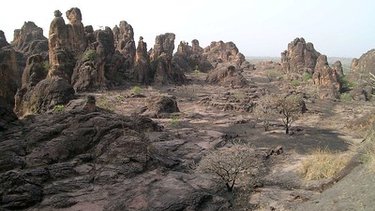Burkina Faso and climate change
Burkina Faso is a Sahelian country with a total surface area of 272,969 km². Its population in 2019 was 20,505,155, with a demographic growth rate of 2.94% per year. The country's development is based on agriculture, a sector that employs 86.8% of the rural population .
Burkina Faso is affected by droughts, floods, heat waves and violent winds, all of which have an impact on people's livelihoods and means of subsistence (PNA, 2024).
Women, the elderly, children and small-scale farmers are the groups most affected by these hazards (PANA, 2007). The overall budget for implementing the NAP (2024-2028) is 2,936.5 billion CFA francs.
The choice of LIFE-AR
Burkina Faso joined LIFE-AR in 2019 and is part of the first cohort. The official launch took place on 27 May 2022.
To implement LIFE-AR, several bodies were set up as part of the institutional arrangement. These bodies made it possible to carry out the establishment phase and to initiate the test and development phase with the support of the local communities.
The involvement of communities in the process of choosing investments in the pilot communes is particularly marked by the dedication of women, young people and people with disabilities, which has helped to develop the LIFE-AR investment plan.
Progress made
At institutional level, LIFE-AR has led to the creation of the following bodies:
- The LIFE-AR Technical Secretariat, set up by memorandum No. 2022/240/MEEEA/SP -CNDD/DCCI of 1 July 2022.
- The LIFE-AR Technical Working Group (TWG), a multi-sector, multi-stakeholder team, set up by memorandum No. 22-00389/ MEEEA/SP -CNDD/DCCI of 05 July 2022; this body, made up of a team with a wide range of skills, has carried out all the studies relating to the implementation of LIFE-AR in Burkina Faso;
- the Steering Committee, set up by memorandum No. 23-435 MEEA/SP -CNDD/DCCI of 19 July 2023. This is a multi-sectoral and multi-stakeholder body which plays the role of coordinating the LIFE-AR initiative. This committee validated the studies drawn up by the TWG;
- Local technical teams. Each pilot commune has issued a decree setting up its local technical team, taking gender and inclusion into account. The local technical teams' understanding of community priorities in terms of adaptation and resilience has enabled them to support these communities in identifying resilient investments;
The bodies that have been set up have drawn up the following documents:
- Capitalising on experience in Burkina Faso in integrating climate adaptation and resilience into local development plans;
- mechanism for implementing LIFE-AR in Burkina Faso ;
- LIFE-AR communication plan ;
- review of policies, systems and capacities in line with LIFE-AR offers and principles;
- intervention guide ;
- MEL manual ;
- administrative, financial and accounting procedures manual ;
- investment plan ;
- due diligence.
Next steps
The next steps in the implementation of LIFE-AR are :
- validation of the MEL manual and of the administrative, financial and accounting procedures by the Steering Committee;
- the signing of agreements between IUCN and the pilot municipalities for delivery of funds;
- making funds available to local authorities so that they can actually start making investments;
- capacity building for stakeholders ;
- monitoring the implementation of investments on the ground.

